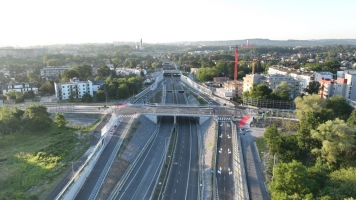Tunnels, railway, tramway and river – commissioning of the Łagiewnicka Route in Krakow

Budimex has completed the construction of the Łagiewnicka Route, one of the most important investments of the city of Krakow in recent years. Under a contract worth around PLN 680 million, Poland’s largest general contractor has handed over the 3.5-kilometre-long route. Construction works started in July 2018 and lasted until June 2022.
The contract with Trasa Łagiewnicka SA was signed by a consortium comprising Budimex and Ferrovial Construction on 17 March 2017. The scope of work included the design and construction of a traffic route from Grota-Roweckiego Street to the intersection of Witosa, Halszki and Beskidzka Streets. An important part of the investment was the preparation of a tram line that connects the Kurdwanów housing estate with Zakopiańska Street. The investor concluded contracts for financing the project with the European Investment Bank and Bank Gospodarstwa Krajowego.
More than 2 km, i.e. most of the 3.5 km of the road that was built, was routed through tunnels, the longest of which is over 700 metres long and is located between the John Paul II Sanctuary and the Divine Mercy Sanctuary. New road junctions, noise barriers, bridges, footbridges and pavements were also built. The course of the Wilga river bed and the route of the nearby Kraków-Skawina railway line were also changed. Bicycle paths were built along the entire investment, as well as a new tram line from Turowicza Street to Zakopiańska Street. Above the tunnels, in the vicinity of Zbrojarzy Street, recreational areas have been created, including a skatepark, sports fields, and playgrounds.
The construction of the Łagiewnicka Route required a comprehensive reconstruction of a highly urbanised area in the vicinity of Zakopiańska Street. At this point, the route crosses one of the main arterial roads into Krakow and railway line No. 94. Traffic had to be permanently maintained on both roads, and the Wilga River also flows through this area. ‘The works were carried out in several stages. First of all, the facilities required to relocate the course of the river to the new, altered riverbed were constructed in sections. This also required the construction of a temporary railway track with a river crossing for trains. Once the river was ‘rerouted’, it was possible to continue work on the sections of road and tram tunnels that had previously been in conflict, and then to reconstruct the railway line on top of their intended route’, says Cezary Lysenko, Director of Infrastructure Construction at Budimex.
‘Construction work was interrupted by heavy rainfall and flooding of the River Wilga, with the largest of such events occurring in August 2021. The Wilga River overran its current bank and flooded part of the Łagiewnicka Route construction site when the river embankments were not yet complete. When work resumed, we were able to raise the river embankment and make additional safeguards, which minimised the risk of the route being flooded’, Cezary Łysenko adds.
As part of the construction of the Łagiewnicka Route, a new tram line of about 1.7 km was also built. Trams will pass through a tunnel for a section of about 700 m. The new tram infrastructure will improve the city’s public transport system and improve living conditions for residents of Krakow’s southern districts.
‘I believe that the construction of the Łagiewnicka Route is one of the most complex engineering contracts carried out by Budimex. The investment required the cooperation of specialists from many industries in the field of construction. At the height of the construction, there were around 450 people and 160 pieces of equipment site at any one time. Coordinating such a team was a major challenge’, summarises Cezary Łysenko, Director of Infrastructural Construction at Budimex.
The completion of the Łagiewnicka Route paves the way for the construction of the western section of the so-called Third Krakow Bypass with the Pychowicka and Zwierzyniecka routes. The new route will contribute to relieving traffic congestion in the area of Krakow’s inner city and improve inter-district traffic, which will result in reduced exhaust emissions and improved air quality.
Basic technical information:
- Reinforcing steel consumption: approx. 20,990,000 kg,
- Concrete consumption: approx. 207,500 m3,
- Area of diaphragm walls built: approx. 60,000 m2,
- Volume of excavation works: approx. 1,340,000 m3,
- Volume of completed embankments and backfills: approx. 570,000 m3.
